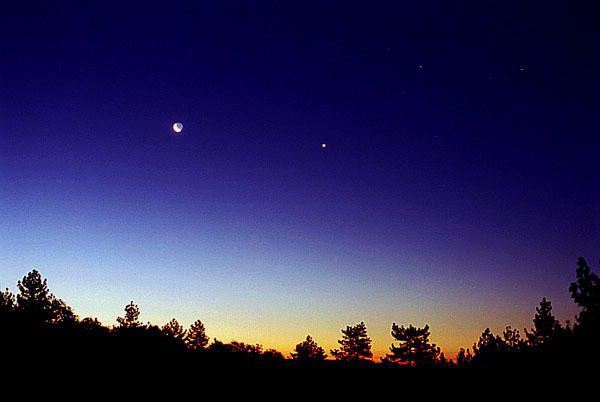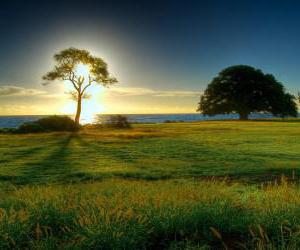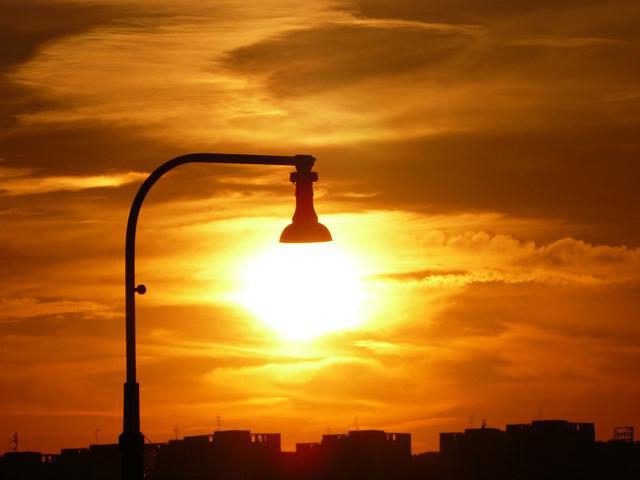The darkest time of the day is in June. When a day is added - or an increase in the length of daylight hours.
All living organisms need and lack sunlight during the seasons when days are short and nights are long. Any cycle has critical points of changing the nature of the cycle. In a duration change cycle daylight hours are the days of the equinox (autumn and spring, distinguishing feature which - the duration of the day and night is aligned), the days of the solstice (summer with the longest and winter with the shortest daylight hours).
When is daylight added?
The hour and day of each critical point shifts depending on the phases of the moon and leap shifts. Day 2015 winter solstice GMT in the northern hemisphere of our planet starts at 4 o'clock. 48 min., in 2016 December 21 at 10 a.m. 44 min., in 2017 December 21 at 16:00 28 min. During these days and hours, the Sun crosses the farthest point of the Earth's elliptical orbit, as a result of which the duration of daylight hours is the shortest. In the southern hemisphere of the Earth, the summer solstice begins at this time.
The phase of increasing daylight hours begins on the day of the winter solstice and ends in the afternoon summer solstice. The intensity of the increase in daylight depends on the angle of declination of the Sun and the speed of its rotation. Practically, the day in the northern hemisphere begins to increase on 24-25.12 for several minutes a day, then the intensity of the increase in the length of the day increases. In 2016 March 20 at 4 o'clock. 30 minutes. the length of the day aligns with the length of the night, reaching the second critical point of the cycle - the spring day, reaching 09/22/2016 at 14:00. 21 min. days autumn equinox, i.e. balancing the length of day and night. The cycle of change in the length of the day ends at the new point of the winter solstice on December 21, 2016, having reached a minimum of the day length.
The critical points of the cycle are the actual characteristic points of the change of seasons. These days were celebrated ancient holidays. December 20 was considered the last day of autumn, and on December 21 the Solstice and Kolyaden were celebrated - the day of the beginning of winter, the new year and the birth of the god Kolyada, who embodied the Sun. Christmas time was celebrated for 21 days with the decoration of the huts with dolls of the god Veles (the current Santa Claus) and the Snow Maiden and the performance of carols. IN magical days Christmas time people predicted crops, dates of wars and weddings, commemorated the dead. The Germanic tribes celebrated Yule ( New Year). Other critical days of the daylight cycle were also associated with folk holidays, because. ancient farmers and pastoralists were completely dependent on the changing phases of natural cycles.
Video that explains everything in detail
Today, they try to link the change in the length of daylight hours with economic feasibility - the subjective translation of the clock hands 1 hour forward or backward in the corresponding phases of the daylight cycle to save electricity. As the practice of the last two decades has shown, subjective interference in natural astronomical processes leads to deplorable results. The 1% savings in electricity costs the countries implementing this experiment a massive increase in the number of injuries, suicides, exacerbation of chronic diseases, conflict situations and other equinoxes. Starting from this point, the length of the day continues to increase, but the intensity of the increase gradually decreases. On June 20, 2016 at 22:34, the Sun crosses the closest point of the Earth's elliptical orbit, the length of the day reaches the 3rd critical point of the cycle - for the summer solstice with the maximum length of the day. Starting from this point, the length of the day begins to decrease,
health disorders caused by a violation of the daily regimen. Most countries, based on statistical data and the conclusions of scientists, abandoned the dubious experiment, Ukraine is not among them yet. It remains to be hoped that the transfer of Ukraine to winter time in 2015 will complete this cycle of experiments that are harmful to public health.
Daylight is the time from sunrise to sunset. Depending on where in its orbit the Earth is located, revolving around the Sun, the length of daylight hours also changes. The longest day of the day is June 21, on this day its duration is 16 hours. The shortest day, which lasts only 8 hours, falls on December 21 or 22, depending on whether the year is a leap year. In the autumn of September 21 and in the spring of March 21, nature celebrates the days of autumn and spring equinox when the length of daylight is equal to the length of night - the time from sunset to sunrise.
The annual cycle depends on the length of daylight hours, to which all life on planet Earth is subject. At the same time, as the length of daylight hours changes, one season changes another: spring is followed by summer, autumn, winter and again spring. This dependence is especially evident in the example of plants. In spring, as the length of daylight increases, sap flow begins in them, in summer you can observe their flowering, in autumn - withering, and in winter - suspended animation, a dream similar to death. But, perhaps, not in such an explicit form, but the duration of daylight hours also affects a person.
The effect of daylight hours on humans
Man, as part of the planet's biosphere, is also sensitive to how long daylight hours last, despite the fact that his life regime is subject to the daily working rhythm. However, the medical research confirmed that in winter the metabolic rate in the human body decreases, resulting in increased drowsiness and the appearance of excess weight.The lack of sufficient natural light also affects the psycho-emotional state. In winter, as well as in early spring, many complain of depression, bad mood, headaches, insomnia and irritability. Dysfunction nervous system provokes malfunctions in the functioning of other organs and systems. In the body, the synthesis of natural vitamin D is reduced, which entails a decrease in the protective properties of the immune system, therefore total amount diseases and exacerbations of chronic pathological processes at this time of the year is the highest. Doctors advise at the end of winter - the beginning of spring at least on weekends to get out into nature, to spend more time during the day on fresh air, it will help to cope with a bad mood and improve overall well-being.
The reduction in the autumn-winter period of daylight hours affects the deterioration of well-being and the weakening of human immunity, the change of the phase of rise by the phase of decline in all life cycles, an increase in the expenditure side of the budgets of countries, the suspension of seasonal work in a number of sectors of the economy ( agriculture, construction, etc.).
The winter solstice marks the shortest daylight hours. On this day, the Sun crosses the farthest point of the ellipse along which the Earth rotates. This day for the inhabitants of the northern hemisphere of our planet comes on December 21-22, at the same time, for the inhabitants of the southern hemisphere, the day of the summer solstice of maximum duration begins.
Sunlight promotes the production of the hormone serotonin in the human body, which causes emotions of joy and happiness. With a short light day, the production of serotonin is reduced, which depresses emotional sphere organism and leads to deterioration of its condition. The equality of the duration of day and night on the days of the autumn and spring equinoxes creates ideal conditions for daily biorhythms. The interval of the cycle, starting on the day of the autumn equinox, and ending on the day of the winter solstice, is a stage in the reduction of daylight hours in the phase of its lagging behind the duration of the night. This stage is the most unfavorable, during which all life on Earth is increasingly oppressed. The second stage, starting on the day of the winter solstice and ending on the day of the vernal equinox, is also in the phase of daylight lagging behind the night, but this lagging is gradually decreasing, Negative influence the lack of sunlight is gradually weakening. The less a person receives per day sun rays, the more he is prone to nervous breakdowns, up to depressive states and mental disorders. The technical civilization is trying to compensate for the lack of sunlight with artificial lighting, to which the human body is not adapted, it perceives artificially lit night hours as daytime hours, falling into the so-called state of desynchronosis, which aggravates chronic diseases.
At the same time, the population of the northern hemisphere feels the influence of the change of seasons less than the population of the southern hemisphere, because in winter, the northern hemisphere is closer to the sun. The interval from sunrise to sunset is called the longitude of the day. This value depends on the geographic latitude. At the equator, the length of the day is a constant of 12 hours. In the northern hemisphere, in the autumn-winter period, the length of the day is less than 12 hours, and in the spring-summer period, more than 12 hours. At the Earth's poles, polar day and night last for six months. Given the importance of the length of the day, daily and average monthly tables of day length for each geographical latitude have been compiled.
For example, the minimum average monthly longitude of a day at the latitude of Moscow is fixed in December at 7 hours 16 minutes and in January at 7 hours 51 minutes.
The benefits and necessity of sunlight for human body is not in doubt. Any of us knows that without it existence is impossible. In winter, we all experience a more or less severe deficiency of it, which negatively affects our well-being and undermines the already unstable immunity.
What happens to daylight
With the onset of the cold season, daylight hours, the duration of which is rapidly decreasing, are increasingly giving way to rights. The nights are getting longer and longer, and the days, on the contrary, are getting shorter. After a period winter equinox the situation begins to change in reverse side which most of us look forward to. Many people want to accurately navigate the length of daylight hours at the present time and in the near future.
As you know, the number of light hours per day begins to increase after the end of the period of the so-called winter solstice. At its peak, daylight hours are recorded annually, the duration of which is the shortest. FROM scientific point From the point of view, the explanation is that the sun is at this time in the most distant point of the orbit of our planet. This is influenced by the elliptical (that is, elongated) shape of the orbit.
In the northern hemisphere, it happens in December and falls on the 21st-22nd. A slight shift in this date depends on the dynamics of the Moon and shifts in leap years. At the same time, the southern hemisphere experiences the reverse period of the summer solstice.
Light day: duration, timing
A few days before and after the date of each solstice, the daylight does not change its position. Only two or three days after the end of the darkest day, the light gap begins to gradually increase. Moreover, at first this process is practically invisible, since the addition occurs only for a few minutes a day. In the future, it begins to brighten faster, this is explained by an increase in the speed of solar rotation.
In fact, the increase in the length of daylight hours in the northern hemisphere of the Earth begins no earlier than December 24-25, and it occurs until the very date of the summer solstice. This day alternately falls on one of three: from 20 to 22 June. The increase in daylight hours has a noticeable positive effect on the health of people.

According to astronomers, the winter solstice is the moment when the sun reaches its lowest angular height above the horizon. After it, for a few, it can begin its sunrise even a little later (for several minutes). An increase in the duration of daylight hours is observed in the evenings and occurs due to an increasingly late sunset.
Why does it happen
This effect is also explained by an increase in the speed of the Earth. You can verify this by looking at the table, which reflects the sunrise and sunset. As astronomers say, the day is added in the evening, but unevenly on both sides. The graph of daylight hours gives a visual representation of the dynamics of this process.
Every day the sunset shifts by a few minutes. Accurate data is easy to follow on the relevant tables and calendars. As scientists explain, this effect is caused by a combination of daily and annual movements of the sun across the sky, which is a little faster in winter than in summer. In turn, this is due to the fact that, turning at a constant speed around its own axis, the Earth in winter is located closer to the Sun and moves in orbit around it a little faster.
The elliptical orbit along which our planet moves has a pronounced eccentricity. This term refers to the amount of elongation of the ellipse. The point of this eccentricity closest to the Sun is called perihelion, and the most distant point is called aphelion.

Kepler's laws state that a body moving in an elliptical orbit is characterized by maximum speed at those points that are as close to the center as possible. That is why the movement of the sun across the sky in winter is slightly faster than in summer.
How does the Earth's orbital motion affect climate?
According to astronomers, the Earth passes the point of perhelion approximately on January 3, and aphelion - on July 3. It is possible to change these dates by 1-2 days, which is associated with the additional influence of the movement of the moon.
The elliptical shape of the Earth's orbit also affects the climate. During the winter in the Northern Hemisphere, our planet is closer to the Sun, while in the summer it is further away. This factor makes the difference between the climatic seasons of our northern hemisphere a little less noticeable.
At the same time in southern hemisphere this difference is more noticeable. As established by scientists, one revolution of the overhelion point occurs in about 200,000 years. That is, in about 100,000 years, the situation will change to the exact opposite. Well, let's wait and see!
Bring on the sunshine!
If we return to current problems, the most important thing for us is the fact that the emotional, mental and the physical state of the inhabitants of the Earth improves in direct proportion to the increase in the length of daylight hours. Even a slight (for a few minutes) lengthening of the day immediately after the winter solstice has a serious moral effect on those tired of the dark winter evenings of people.

Medically, positive influence sunlight on the body is due to an increase in the production of the hormone serotonin, which controls the emotions of happiness and joy. Unfortunately, in the dark, it is produced extremely poorly. That is why an increase in the duration of the light interval by influencing the emotional sphere leads to a general improvement in well-being and strengthening of human immunity.
A significant role in the sensations of each of us is played by daily internal biorhythms, which are energetically tied to the alternation of day and night that has continued since the creation of the world. Scientists are sure that our nervous system can adequately work and cope with external overloads only if it regularly receives a well-defined dose of sunlight.
When the light isn't enough
If there is not enough sunlight, the consequences can be the saddest: from regular nervous breakdowns to serious mental disorders. With an acute lack of light, a real depressive state can develop. And seasonal affective disorders, which are expressed in depression, bad mood, general decrease emotional background observed all around.
In addition, modern citizens are subject to another misfortune. Daylight hours, the duration of which is too short for modern urban life, require adjustment. We are talking about a huge, often excessive amount of artificial lighting, which is received by almost any resident of the metropolis. Our body, unadapted to such an amount of artificial light, is able to get confused in time and fall into a state of desynchronosis. This leads not only to a weakening of the nervous system, but also to the exacerbation of any existing chronic diseases.

What is day length
Let us now consider the concept of the length of the day, which is relevant for each of us in the first days after the winter solstice. This term refers to the period of time that lasts from sunrise to sunset, that is, the time during which our luminary is visible above the horizon.
This value is directly dependent on the solar declination and the geographical latitude of the point where it needs to be determined. At the equator, the length of the day does not change and is exactly 12 hours. This figure is borderline. For the northern hemisphere in spring and summer, the day lasts longer than 12 hours, in winter and autumn - less.
Autumn and spring equinox
The days when the length of the night coincides with the length of the day are called the days of the spring equinox, or autumn. This happens on March 21 and September 23 respectively. It is clear that the longitude of the day reaches its highest figure at the time of the summer solstice, and the lowest - on the winter day.
Beyond the polar circles of each of the hemispheres, the longitude of the day goes off scale in 24 hours. It's about everything known concept polar day. At the poles, it has a duration of as much as half a year.

The length of the day at any point in the hemisphere can be determined quite accurately using special tables containing the calculation of the length of daylight hours. Of course, this number changes daily. Sometimes, for a rough estimate, he uses such a concept as average duration daylight hours by month. For clarity, consider these figures for the geographical point where the capital of our country is located.
Daylight hours in Moscow
In January daylight hours at the latitude of our capital average 7 hours 51 minutes. In February - 9 hours 38 minutes. In March, its duration reaches 11 hours 51 minutes, in April - 14 hours 11 minutes, in May - 16 hours 14 minutes.
For three summer months: June, July and August - these figures are 17 hours 19 minutes, 16 hours 47 minutes and 14 hours 59 minutes. We see that June which corresponds to the summer solstice.
In autumn, daylight hours continue to decrease. In September and October, its duration is 12 hours 45 minutes and 10 hours 27 minutes, respectively. The last cold dark days - November and December - are famous for record-breaking short bright days, the average duration of which does not exceed 8 hours 22 minutes and 7 hours 16 minutes, respectively.
